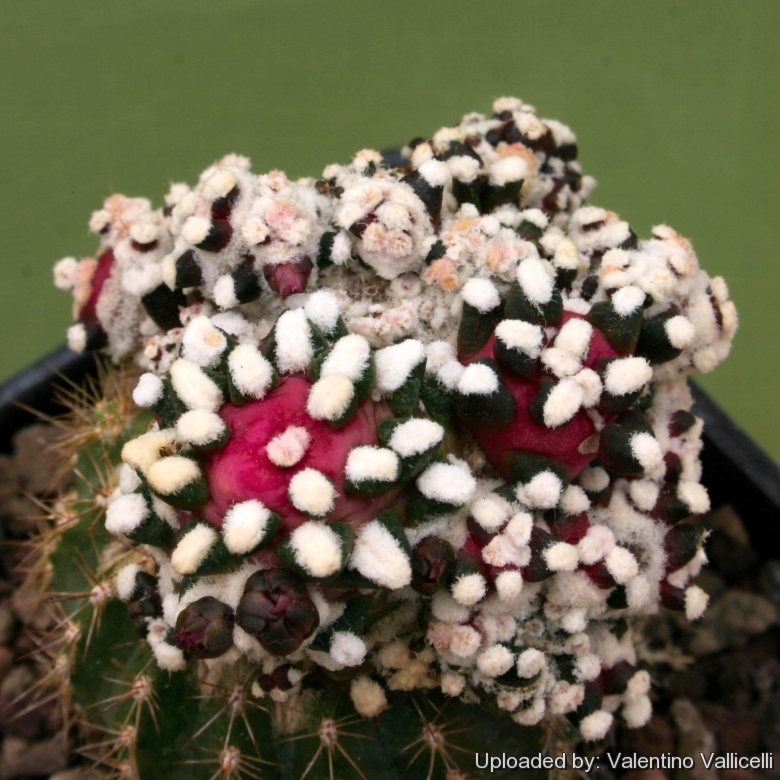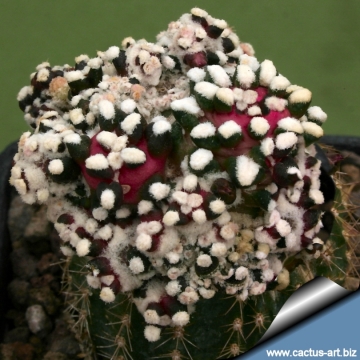Accepted Scientific Name: Ariocarpus kotschoubeyanus (Lem. ex K.Schum.) K.Schum.
Bot. Jahrb. Syst. 24: 550. 1898 [ et: Nat. Pflanzenfam. Nachtr. [Engler & Prantl] 1: 259. 1897 ]

Ariocarpus kotschoubeyanus f. monstruosus Photo by: Valentino Vallicelli
Origin and Habitat: Garden origin (Nursery produced cultivar)
Synonyms:
See all synonyms of Ariocarpus kotschoubeyanus
back
Accepted name in llifle Database:Ariocarpus kotschoubeyanus (Lem. ex K.Schum.) K.Schum.Bot. Jahrb. Syst. 24: 550. 1898 [ et: Nat. Pflanzenfam. Nachtr. [Engler & Prantl] 1: 259. 1897 ]Synonymy: 27
back
Description: Ariocarpus kotschoubeyanusSN|2127]]SN|2127]] is a very flat geophyte cactus that produce small star-shaped rosettes. The monstrous form Ariocarpus kotschoubeyanusSN|2127]]SN|2127]] f. monstruosus is an odd plant that forms bumped shapes, it is very colourful, the epidermis is dark green and contrasts with the large white areoles and new purple-red growth, and it is possible to find clones with different degrees of monstrosity or deformity. The flowers shows a great degree of variability too. Maybe we can call it a freak? Despite to its beauty it is still very rare and sought after by collectors, for its unique features.
Habit: It is a highly branching cactus that forms densely packaged clumps.
Roots: These plants are almost always seen grafted on tall columnar cacti, but can be rooted and in this case they grow a large tap root below the surface of the compost.
Stem: Small sized and giving rise to numerous side shoots from old areoles, flattened on top, depressed centrally.
Tubercles: The tubercles are hatchet shaped to deltoid, much smaller than the type species, dark olive green with no spines and are more long than wide, closely packed and divergent, sharply angled apically.
Areoles: The tubercles forms a woolly central areole extending longitudinal, 1-3 mm wide, 5-10 mm long and often covering the whole apical part of a tubercle.
Flowers: Usually failing to open, if opening they are very small and emerging from the areoles on the top, bright pink-violet and more or less monstrous.
Blooming time: Mid-September onwards.
Fruits: Not seen.
Subspecies, varieties, forms and cultivars of plants belonging to the Ariocarpus kotschoubeyanus group
 Ariocarpus kotschoubeyanus (Lem. ex K.Schum.) K.Schum.: Very flat geophyte cactus that produce small star-shaped rosettes. They in most cases don't reach more than only a few centimetres above the ground. The type species is intermediate between all the other forms and is to be found off highway 80, between El Huisache Junction and Santo Domingo.
Ariocarpus kotschoubeyanus (Lem. ex K.Schum.) K.Schum.: Very flat geophyte cactus that produce small star-shaped rosettes. They in most cases don't reach more than only a few centimetres above the ground. The type species is intermediate between all the other forms and is to be found off highway 80, between El Huisache Junction and Santo Domingo. Ariocarpus kotschoubeyanus subs. albiflorus (Backeb.) Glass: This is a small growing form with white flowers described in Tamaulipas.
Ariocarpus kotschoubeyanus subs. albiflorus (Backeb.) Glass: This is a small growing form with white flowers described in Tamaulipas. Ariocarpus kotschoubeyanus f. cristatus hort.: The crested form is and can get relatively large making a spectacular specimen. The appeal lies in the peculiarly-shaped tubercles plus the challenge of growing it successfully.
Ariocarpus kotschoubeyanus f. cristatus hort.: The crested form is and can get relatively large making a spectacular specimen. The appeal lies in the peculiarly-shaped tubercles plus the challenge of growing it successfully. Ariocarpus kotschoubeyanus var. elephantidens Skarupke: Southerly form.They are much larger than type with larger, highly textured, triangulate tubercles, and a deep purple flower with little or no white content.
Ariocarpus kotschoubeyanus var. elephantidens Skarupke: Southerly form.They are much larger than type with larger, highly textured, triangulate tubercles, and a deep purple flower with little or no white content. Ariocarpus kotschoubeyanus var. elephantidens f. cristata hort.: crested form with distinguishing much larger and highly textured, triangulate tubercles.
Ariocarpus kotschoubeyanus var. elephantidens f. cristata hort.: crested form with distinguishing much larger and highly textured, triangulate tubercles. Ariocarpus kotschoubeyanus var. macdowellii (Backeb.) Krainz: This are the plants found in northern populations, they are smaller than the type, with small beak-like tubercles and pale mauve flowers, often with a high white content in the outer petals.
Ariocarpus kotschoubeyanus var. macdowellii (Backeb.) Krainz: This are the plants found in northern populations, they are smaller than the type, with small beak-like tubercles and pale mauve flowers, often with a high white content in the outer petals. Ariocarpus kotschoubeyanus f. monstruosus hort.: It foms monstrous bumped shapes, it is very courfull, the epidermis is dark green and contrasts with the large white areoles and new purple-red growth.
Ariocarpus kotschoubeyanus f. monstruosus hort.: It foms monstrous bumped shapes, it is very courfull, the epidermis is dark green and contrasts with the large white areoles and new purple-red growth. Ariocarpus kotschoubeyanus f. mostruosus proliferus hort.: It is a very proliferous form with thin dark heads covered with tiny contrasting white woolly areole. Older plants will produce small cushions with hundreds of heads.
Ariocarpus kotschoubeyanus f. mostruosus proliferus hort.: It is a very proliferous form with thin dark heads covered with tiny contrasting white woolly areole. Older plants will produce small cushions with hundreds of heads. Ariocarpus kotschoubeyanus subs. neotulensis Halda
Ariocarpus kotschoubeyanus subs. neotulensis Halda Ariocarpus kotschoubeyanus f. rubra hort.: has tubercles of a bright orange-red colour due to the absence (or reduced production) of chlorophyll pigments.
Ariocarpus kotschoubeyanus f. rubra hort.: has tubercles of a bright orange-red colour due to the absence (or reduced production) of chlorophyll pigments.- Ariocarpus kotschoubeyanus subs. skarupkeanus Halda & Horáček
 Ariocarpus kotschoubeyanus subs. sladkovskyi Halda & Horáček: Differs from the other red flowering A. kotschoubeyanus (that have a dull and rough epidermis) for having a smoother and shiny epidermis.
Ariocarpus kotschoubeyanus subs. sladkovskyi Halda & Horáček: Differs from the other red flowering A. kotschoubeyanus (that have a dull and rough epidermis) for having a smoother and shiny epidermis.
 Ariocarpus kotschoubeyanus f. monstruosus Photo by: Cactus Art
Ariocarpus kotschoubeyanus f. monstruosus Photo by: Cactus ArtSend a photo of this plant.The gallery now contains thousands of pictures, however it is possible to do even more. We are, of course, seeking photos of species not yet shown in the gallery but not only that, we are also looking for better pictures than those already present.
Read More... Cultivation and Propagation: Ariocarpus kotschoubeyanusSN|2127]]SN|2127]] f. monstruosus is not too difficult in a greenhouse, although grows quite slowly. It is usually seen as a grafted plant but can be cultivated on its own roots too.
Soil: Use a mineral well permeable soil with little organic matter (peat, humus).
Exposure: They need a good amount of light shade to full sun this help to keep the plants healthy, although slow growth. Keep well ventilated, as it is prone to root rot.
Watering: Water sparingly from March till October (weekly during summertime, if the weather is sunny enough), with a little fertilizer added. Less or no water during cold winter months, or when night temperatures remain below 10° to prevent root loss. It is sensitive to overwatering (rot prone).
Fertilization: Feeding may not be necessary at all if the compost is fresh then, feed in summer only if the plant hasn't been repotted recently. Do not feed the plants from September onwards as this can cause lush growth which can be fatal during the darker cold months.
Hardiness: Keep perfectly dry in winter at temperatures from 5 to 15 degrees centigrade. In the rest period no high atmospheric humidity!!
Monstrous growth: Monstrous varieties of plants, where the variation from normal growth is due to genetic mutation, can occur randomly on normal plants. Sometimes it's due to damage, but generally the causes are unknown. A monstrous plant may may revert to normal growth for no apparent reason.
Propagation: Grafting (usually) or by cuttings that are hard to root. Plants are usually grafted onto column-shaped cacti but proved to be able to produce their own roots if degrafted. Cuttings will take root in a minimum temperature of 20° C (but better in hot weather).











